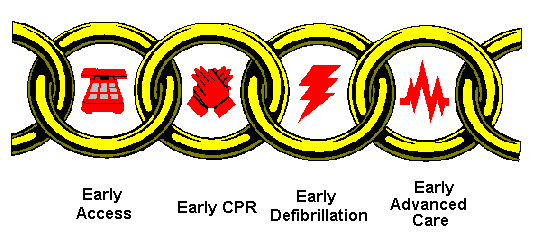THIS IS PAGE 6. PUT AWAY THE TOYS. WE ARE GOING TO LEARN ABOUT EMS, AND HOW TO SAVE LIVES! ARE YOU PREPARED FOR AN...
![]() ???
???

![]()
HEART ATTACK AND STROKE
Beginning today, and over the next 365 days, nearly 900,000 deaths will occur due to cardiovascular disease. Nearly a half a million lost due to heart attack. Sadly, many of these deaths could have been prevented if family members or bystanders had an understanding of the symptoms of heart attack. About 66% of heart attack victims die within 1 to 2 hours after the onset of symptoms. Hence, it is extremely important that we learn and understand these symptoms, and know what steps to take, at symptom onset. Lets learn what these symptoms are!
I would like to preface my heart attack symptoms list by saying that the number one symptom of heart attack is "denial" of possibly having one! No one wants to have a heart attack. Just like an alcoholic, or a person addicted to drugs...they did not want to become addicted. We can see the similarities between these illnessness concerning denial. In the case of denial with heart attack I have heard victims say countless times, "It was something I ate that's not agreeing with me. I'll be alright."
SYMPTOMS OF HEART ATTACT
1. Chest discomfort, usually in the center of the chest.
2. Shortness of breath; breathing difficulty.
3. Increased to profuse sweating for no other reason like exercise.
4. Nausea, or feeling sick to the stomach.
Upon recognizing these symptoms, it is crucial to activate the Emergency Medical Services by calling 911, or your local Emergency number. The American Heart Association refers to this as the first step in the "Chain of Survival." No, I don't drive around in the ambulance looking for people exhibiting the above symptoms, or looking for someone to fall over. You must call now. Never second guess; call EMS. Below is the American Heart Associations, "Chain of Survival."

The first two steps are your responsibility as a citizen. Early Access; call 911 NOW, and be prepared to do CPR. We will learn how to do adult CPR in another lesson. The last two steps in the "Chain of Survival," is the work of the Emergency Medical Services. If the EMS system is not activated quickly, a person having symptoms of a heart attack will experience cardiac arrest. This is when the heart abruptly stops beating altogether, and the victim stops breathing and becomes unconscious...at this point, the victim has to be revived within 10 minutes. Without Oxygen the brain will die at 10 minutes. Without early intervention by EMS at this point, death is certain. At the onset of symptoms, call 911 NOW!! Now we will learn about the next two steps in the "Chain of Survival."
Early Defibrillation...this is provided by highly trained by EMS personel. A heart that is not beating adequatley enough to supply the brain with is required oxygen, defibrillation is necessary. Defibrillation is the delivery of an electrical shock to the heart in an attempt to establish a normal heartbeat. It stops the abnormal one. The earlier this shock is delivered, the more likely the victim will survive. Early Advanced Care is the use of lifesaving cardiovascular medications to bring about a normal cardiac rythm. Some of these lifesaving medicines are: Epinephrine, Atropine, Nitroglycerin, Dopamine and Morphine, just to name a few. In the system that I work for these medications are delivered during early defibrillation, always intravenously. These medications are not delivered as a shock is being delivered. Everyone must NOT be in contact with the patient in any way during the delivery of an electric shock for obvious reasons. We do not need more than one patient at this juncture!! Hence, before a shock, you will hear the paramedic, or EMT-D announce rather loudly..."CLEAR...EVERYBODY CLEAR"...hopefully everyone is clear if the patient!! It is before and after the delivery of a shock are these medications administered. During all of this, other EMS personnel are preparing to place the patient on the ambulance gurney...for rapid transport to the closest hospital...with excellant teamwork it is very fast, smooth and effective for the patient...it is poetry in motion...lifesaving poetry in motion that could not have happened without you...the citizen who knew the early warning signs and symptoms of a heart attack. You are the true hero!!
For those of you who have never seen a defibrillator, here is the one that I am most familar with...the "Lifepak 10," a lifesaving device manufactured by Physio-Control, of Redmond, Washington.

For information about Physio-Control, visit their site!![]()